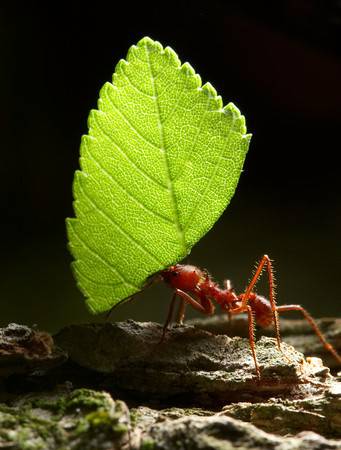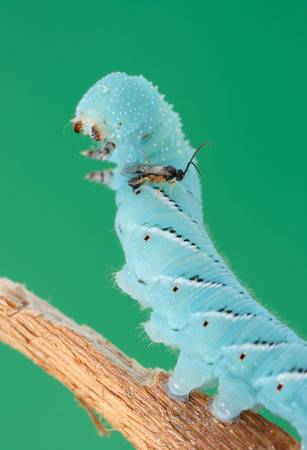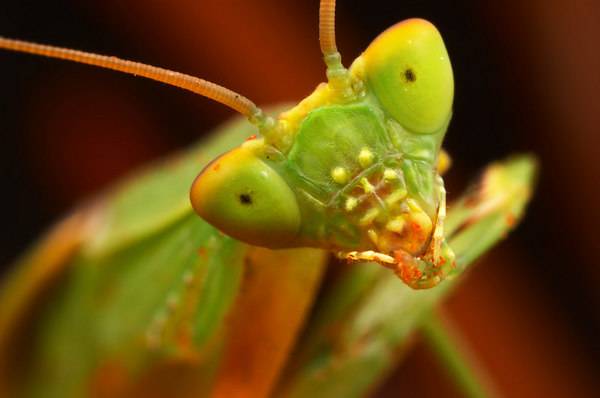 In the small world of insect photography, Alex Wild is a big deal. The 37-year-old UI biologist has sold and loaned his images of ants and other insects to a variety of publications and media, including – to name just a few of the best known ones: National Geographic, The New York Times, The Washington Post, Discovery Channel, and USA Today. However, Wild didn’t set out to become “The Michael Jordan of ant photography,” as he was once described in an interview. When I spoke to him recently, he described his photography success as “an accident.” He added, “It’s a hobby that pays for itself.”
In the small world of insect photography, Alex Wild is a big deal. The 37-year-old UI biologist has sold and loaned his images of ants and other insects to a variety of publications and media, including – to name just a few of the best known ones: National Geographic, The New York Times, The Washington Post, Discovery Channel, and USA Today. However, Wild didn’t set out to become “The Michael Jordan of ant photography,” as he was once described in an interview. When I spoke to him recently, he described his photography success as “an accident.” He added, “It’s a hobby that pays for itself.”
In 2002, Wild began taking photos on a digital camera of insects he found in his neighborhood. After he put the images on his personal website, he found himself getting requests to use them from various photo editors who had discovered them through Google. Eventually, he began licensing and selling his images, although he encourages to this day their free use for educational purposes so long as he’s acknowledged.
Wild, a postdoctoral researcher at the UI who studies the evolutionary history of insects, has long had a fascination with the natural world, especially ants. “I was collecting ants when I was maybe four or five,” he said. “When I was a kid I was raising butterflies and caterpillars, I had a jar full of tadpoles, but I really gravitated towards ants… I still don’t know why, really. Maybe it’s because they’re social. We can relate to social insects, but it’s really kind of a false analogy. We’re only marginally social relative to ants and bees. We have a degree of independence. If you were to try to force us into the kind of societies that bees and ants have, it would not work. Ants are communists to the full extreme.”
Wild has worked at the UI for the last two years. This summer, he’s teaching a class on beekeeping, a subject he also taught about a decade previously during a stint in Paraguay for the Peace Corps. He reflected, “The beekeeping here is really quite different. It’s a different set of concerns. In Paraguay, I was working with farmers who make $400 a year. Most of the beekeeping I taught was on how to make your own equipment and how to get bees out of the forest. Here, you mail order everything. And the bees themselves are different. In the tropics you have bees that are really aggressive; here they’re more mellow, but get hammered by every disease.”
Wild lives in Urbana, and his photographs that wind up in textbooks, documentaries, and advertisements for pest control products are sometimes literally taken in his backyard. He said, “The really great thing about insect photography is that you don’t have to go very far.”
 However, he sometimes heads downstate in search of different species and environments: “Once you hit Southern Illinois, it is quite a bit more rich because you are getting into that never-glaciated area,” he said. “It’s warmer. There are Army Ants. You can find Army Ants in Southern Illinois.”
However, he sometimes heads downstate in search of different species and environments: “Once you hit Southern Illinois, it is quite a bit more rich because you are getting into that never-glaciated area,” he said. “It’s warmer. There are Army Ants. You can find Army Ants in Southern Illinois.”
Around C-U, he also finds his tiny subjects in Crystal Lake Park and on campus. I asked him if people ever give him odd looks as he scours the ground in search of ants and insects. He answered, “I’m sure they do, but I’ve long since stopped caring about that, since there’s nothing you can do.”
In a blog entry, Wild mentions that as his business gains customers, he has to stage more of his insect shots in order to fulfill specific client requests. He also plans shots in advance just so they’ll look better. He writes: “With precise control over composition and lighting I can walk away with a good image nine times out of ten.”
Whereas, the other types of shots Wild gets come from basically wandering around in the woods hoping to happen on an insect scenario worth photographing. I asked him whether the planned or accidental shots bring him more satisfaction. He replied, “I find that when I plan out the shots and make a list of things I need, things go more smoothly. However, there’s still something about wandering around in the woods and saying, ‘Whoa, there’s something I haven’t seen before!'”
As an example of the last, he described a situation he encountered in South Africa when he happened on ants running around on a tree trunk. Flies were swooping in on the ants. Wild used his camera like a microscope to zoom in and figure out what was happening — the flies were pinning down the ants, which triggered a reflex in the ants to regurgitate the food they were carrying in their stomachs. The flies would then eat the food themselves. Wild took pictures and also eventually turned his observations of the incident into a scientific paper.
Wild reflected that advancing technology has made insect photography a more accessible activity: “I started doing photography after the digital revolution. For me, the big change is that it’s put a camera in everyone’s hands. The optics of some of these cameras are really spectacular. Even some of the cell phone cameras can really kind of get you down into the world of insects in a way that the older film cameras tended not to do. It’s kind of like when binoculars came out, and suddenly, because of binoculars and field guides, there was this whole new hobby.”
The fact that gardeners and hobbyists are now creating their own high-quality images of insects doesn’t mean that the average person can necessarily make money doing insect photography, however. Wild mentioned that, in the past, one “barrier to entry” for making it as a professional photographer was the high cost of equipment. That barrier may be gone now, but there are still others.
He said, “The photographers who are making a living are in areas where there are other barriers to entry. For instance, high end glamour and fashion photographers are doing just fine because not just anyone with a camera is going to be allowed into Vogue’s fashion shoot.”
When it comes to professional insect photography, he feels a barrier to entry is scientific knowledge. It’s a barrier which doesn’t hold him back since he knows what he’s photographing. He said, “You could produce the best ant photo ever, but if you can’t put a Latin name on it and describe the behavior, you’re unlikely to be able to sell it to the editorial market.”
 He added, “I really see the photography as another way to market my PhD rather than my photography skills. If you look at the skill level of professional photographers out there, I’m nothing special. I just found a niche.”
He added, “I really see the photography as another way to market my PhD rather than my photography skills. If you look at the skill level of professional photographers out there, I’m nothing special. I just found a niche.”
The bulk of his time goes to his day job researching insects at the UI, and Wild is happy with this arrangement. He said, “I have a balance between research and photography that works really well. I really like designing the experiments, collecting the data — the in the trenches stuff.”
He added, “I wouldn’t want to do only photography because I’d lose touch with the subject matter expertise. I find that the two complement each other really well.”
Indeed, if you look at Wild’s blog, there’s plenty of advice on techniques for photographing insects (see “Photo tip – focus on the eyes“), but there’s even more highly specialized entomological entries, like the Monday Night Mystery entries where he posts an image of an unidentified insect and lets the other insect people who read his blog guess what species it is. In short, scientific knowledge comes first.
There are also links on Wild’s blog to various documentary videos — ones on science in general and insects in particular. I asked him if taking still photos might lead to one day making ant-related movies. He replied, “I think a lot about it, because that’s where the industry is going.”
However, he feels that video requires a skill set that he’s still developing: “I’ve been shooting little videos and editing them, but I’m coming to realize that it’s not just pictures that move, it’s an entirely different genre,” he said. “With a still picture, you capture a moment in time and present it to the viewer and they sort of have their own experience with it. But as soon as the picture starts moving, you’re involved in a very linear narrative and if you’re not driving it to the right place it seems wrong very quickly. There’s a sense of storytelling that’s a whole other talent.”
Wild worked in the past with a National Geographic film crew shooting a film on ants in the Arizona desert, but as a scientific consultant and ant wrangler rather than a videographer. He said, “I knew how to find the ants and to get them to perform. You want the ants to run around but you don’t have a lot of time to wait for it to rain, so you use a watering can… that kind of stuff.”
So Alex Wild Photography probably won’t become Alex Wild Studios any time soon. He said of film versus still photography: “It’s much more involved. You have to have more equipment, more mics, more assistants. There’s all this peripheral stuff. With a still camera, it’s just you and the camera. I’d probably want to spend a few years practicing before I tried to do anything professional.”
 When I spoke with Wild, he cheerfully and comprehensively fielded all of my insect related questions. Some excerpts:
When I spoke with Wild, he cheerfully and comprehensively fielded all of my insect related questions. Some excerpts:
Q: How can ants create such complex civilizations?
“Think of ants as little robots: they have maybe twenty simple things they can do. Twenty algorithms. On its own, a behavior means nothing — maybe you have an ant running in a circle. But if you have many ants following the same rules, and if the rules are right, suddenly you’ll have an anthill.”
Q: Do ants ever fight each other for the hell of it?
“I don’t think so. I think what sets mammalian brains apart is that we do things for the hell of it. Ants don’t play. It may be because of how small their brains are.”
Q: Will there be another plague of aphids in C-U this autumn?
“I wish I knew. The people to pay attention to are the farmers to the north of us and the problems they’re having with soy aphids. It turns out those aphids were actually blown here. But that was spectacular; I wasn’t expecting to see that.”
In conclusion, visit Wild’s website if you’re a teacher, student or researcher who needs an image of a particular insect for educational purposes (it’s free provided you link back to the site), or if you’re someone else who’s willing to pay for some of the best insect photography in the world (a 5 x 7 print of a horse fly costs $29.95). But don’t be surprised if you notice that there are less images of spiders than of other insects — the Michael Jordan of ant photography has a mild case of arachnophobia: “I don’t like spiders,” Wild said, “I could have a thousand ants on me and I’m cool with it, but put a spider on me and I’m on edge. I don’t know what it is; I think it’s genetic.”
All pictures courtesy of Alex Wild Photography








